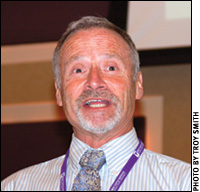ISBCW 2016:
Summary of Past ISBCW Welfare Symposia
by Troy Smith, field editor
MANHATTAN, Kan. (June 8, 2016) — Joe Stookey admits that he once had a more “cavalier” attitude toward animal welfare. Several years ago, the University of Saskatchewan professor of animal behavior was most interested in how maternal and social behavior among cattle, sheep and swine impacted the animals’ productivity. Speaking at the fifth International Symposium on Beef Cattle Welfare, hosted by Kansas State University (K-State) June 8-10, 2016, Stookey said his attitude is different now.
“It has changed me,” stated Stookey, recounting the subject matter addressed during the four previous cattle welfare events, hosted biennially since 2008. “I think it has influenced the attitudes of a lot of people.”

“I would have thought that the economics of animal welfare would have been discussed more [in past symposia],” said Joe Stookey, University of Saskatchewan professor of animal behavior. “Maybe it should be in the future.”
Stookey credited Dan Thomson, Kansas State University veterinary science professor and former Beef Cattle Institute director for organizing the first welfare symposium hosted on K-State’s Manhattan campus. Stookey said Thomson and his team advocated for further discussion of animal welfare, as a global issue and an essential part of growing concern over the sustainability of food animal production systems and management practices.
A second symposium was hosted in Manhattan in 2010. The international focus was reinforced and off-site viewing was provided via the Internet when the 2012 symposium was hosted in Saskatoon, Saskatchewan. Iowa State University hosted the 2014 event in Ames and the 2016 symposium returned to Manhattan.
According to Stookey, the welfare of feedlot animals was the focus of many early symposia discussions, because the feedlot segment was most often targeted by critics. Focus broadened to include the cow-calf and stocker segments, with attention given to specific issues, including compromised cattle, environmental stress, lameness, pain mitigation and weaning.
“Discussion of beta agonist and antibiotic use were added, and those became hot topics,” said Stookey. “Dairy animal welfare was included because of that industry’s contribution to beef production, and because consumers don’t necessarily recognize the distinction between dairy and beef operations."
Stookey noted how past symposia discussions coincided with — and contributed to — related discussions by organizations representing veterinary professionals, cattlemen’s associations in the United States and Canada, as well as the World Trade Organization and the World Organization for Animal Health (OIE).
“During this time, Canada also developed its Code of Practice for Care and Handling of Beef Cattle,” added Stookey. “Released in 2013, it gives [Canadian beef producers] ‘social license’ to conduct recommended animal management practices.”
Stookey said welfare issues will continue to emerge and evolve with changes in beef production influenced by scientific advances and the perceptions of both consumers and producers.
“I would have thought that the economics of animal welfare would have been discussed more [in past symposia],” added Stookey. “Maybe it should be in the future.”
Watch for additional coverage of the 2016 ISBCW on www.angus.media and in the Angus Journal and Angus Beef Bulletin. Comprehensive meeting coverage will be archived at www.api-virtuallibrary.com/meetings_other_news.html.
Editor’s Note: The articles used within this site represent a mixture of copyrights. If you would like to reprint or repost an article, you must first request permission of Angus Media by contacting the editor at 816-383-5200; 3201 Frederick Ave., Saint Joseph, MO 64506. Angus Media claims copyright to this we site as presented. We welcome educational venues and cattlemen to link to this site as a service to their audience.
